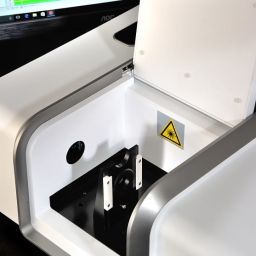- Bulk polymerization
- Solution polymerization
- Suspension (pearl) polymerization
- Emulsion polymerization
Bulk Polymerization
- Bulk polymerization is a homogeneous process which uses an organic initiator
- Two possibilities:
– polymer soluble in monomer (example: polystyrene)
– polymer insoluble in monomer (example: vinylidene chloride)
- polyvinylidene chloride precipitates out of the solution of vinylidene chloride monomer when it reaches a certain molecular weight
- polystyrene is soluble in styrene to infinite molecular weight
- If the polymer is soluble in the monomer, then some physical changes occur with
increasing molecular weight (e.g., viscosity, etc.)
- The higher the temperature, the lower the molecular weight of the polymer produced. At higher temperatures, the initiator decomposes to form radicals at a faster rate, then for a given amount of monomer with more radicals present more polymer chains will be started (initiated), and the resulting polymers will have a lower molecular weight
- Example: If you have 2000 monomer molecules, and 5 chains are initiated, then the
average molecular weight will be 400, but if 10 chains are initiated, then the average
molecular weight will be 200
- We can have continuous polymerization at very low temperatures if we use light to
convert the initiator molecules to radicals (which will start the polymerization)
Bulk polymerization – drawbacks
- The thermal conductivity of monomers and polymers is low, and as the viscosity builds up, the ability for heat transfer via convection is substantially diminished. If the heat energy cannot be dissipated, temperature rises, and at higher temperatures the reaction is going to go faster, so this is a positive feedback loop with disastrous consequences.
- Removal of unreacted monomer can be a problem.
Solution Polymerization
- The main advantage of a solvent (either water or an organic solvent) is to take up the heat of polymerization.
For solution polymerizations, there are two possibilities:
– Both the monomer and polymer are soluble in the solvent
- example: polystyrene in toluene
– monomer is soluble and the polymer is insoluble in the solvent
- example: acrylonitrile in chloroform
- The advantage of solution polymerization over bulk polymerization is better heat control
The disadvantage solution polymerization is the removal of the solvent from the polymer. This requires a distillation, and that costs an appreciable amount of money.
Suspension Polymerization
- It is used only in free radical type processes
- The monomer is mechanically dispersed in a media, usually water. There are cases where an organic media is used in which neither the polymer nor the monomer are soluble in the organic media.
- There are two separate phases throughout the whole process.
- The initiator used can be water soluble or organic soluble [benzoyl peroxide, AIBN, or (NH4)2(SxO4)y]. Usually the initiator is organic soluble.
- The droplets must be kept far apart. This requires agitation: consistent, efficient, and controlled. A suspending agent can be used. Poly(vinyl alcohol) dissolved in the aqueous phase is a typical suspending agent.
- A suspension agent is a material that gives a surface activation that keeps droplets from become larger (droplets coming together to form larger droplets is called coalescence)
- Examples include the polymerization of MMA, and vinyl chloride.
.• Particle size may be 0.01 to 0.5 cm, or as low as 1 micron.
- Suspension polymerization is similar to bulk polymerization, and it could be considered “bulk polymerization within a droplet.”
- The rate of suspension polymerization is similar to the rate of bulk polymerization, but the heat transfer is much better.
Limitations of suspension polymerization
- It only applies to free radical process
- Ionic catalysts don’t work because they compete with water
- Agitation is critical because as the viscosity within the bead rises, the reaction rate
increases suddenly (Tromsdorff effect.) This leads to a sudden increase in heat generation which does not usually occur in solution or emulsion polymerization
Emulsion Polymerization
- The definition for emulsion is: “A stable colloidal suspension as milk, consisting of an immiscible liquid dispersed and held in another liquid by a substance called an emulsifier”.
- components of emulsion polymerization
- monomer, • media (water) • emulsifier, or the surfactant
- minor amount of mechanical stirring • initiator • stabilizer (suspension agent)
- The basic difference between the suspension process and the emulsion process is the surfactant
- Surfactants (soaps) stop particles joining together
- like dissolves like
- water-hating tails go into water-hating polymer
- water-loving heads go into water
- form a stabilised latex
- e.g. with SDS, latex surface covered in negatively charged surfactant head groups
- charge repulsion of ionic head groups stops coalescence
- For an emulsion polymerization process the small droplets are stabilized by the
surfactant.
- The initiator can be either in the aqueous or the organic phase. This is a difference between emulsion and suspension polymerization.
- Initially, a small amount of agitation is need




